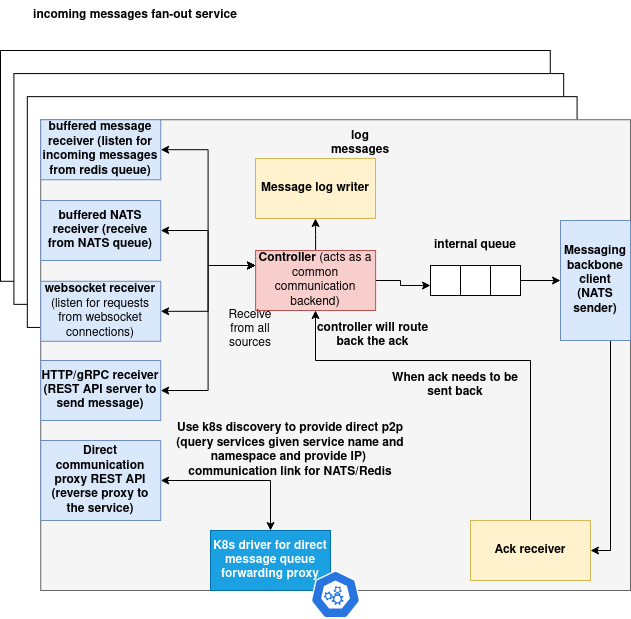Fanout Service Documentation
Introduction
The Fanout Service functions as a gateway and protocol translation layer for a distributed communication mesh. Its main objective is to enable external systems to deliver structured messages into an internal messaging infrastructure based on NATS. The service abstracts away protocol-specific details from clients and offers a unified path into the backend system.
Key Responsibilities
- Acts as a message ingestion gateway
- Supports multiple external protocols for message delivery
- Bridges frontend protocols to an internal backend using NATS
- Provides message logging to a persistent Redis queue for audit and debugging
Architecture

Supported Frontend Protocols
The Fanout Service supports the following protocols for incoming messages:
| Protocol | Transport Type | Endpoint Description |
|---|---|---|
| HTTP | REST API | Accepts POST requests to /MESSAGES |
| WebSocket | Duplex channel | Accepts WebSocket frames at /MESSAGES |
| Redis | Queue listener | Blocks on a Redis list (BRPOP) named MESSAGES |
| NATS | Subscription | Subscribes to a subject called MESSAGES |
All incoming messages are JSON payloads and must contain a topic field indicating the backend NATS topic to which the message should be routed.
Pushing Messages Using Each Protocol
HTTP
Endpoint
POST /MESSAGES
Content-Type: application/json
Payload
{
"message": "{\"topic\": \"internal.updates\", \"data\": {\"value\": 42}}"
}
Python Example
import requests
import json
message = {
"topic": "internal.updates",
"data": {"value": 42}
}
response = requests.post(
"http://<host>:<port>/MESSAGES",
json={"message": json.dumps(message)}
)
print(response.json())
cURL Example
curl -X POST http://<host>:<port>/MESSAGES \
-H "Content-Type: application/json" \
-d '{"message": "{\"topic\": \"internal.updates\", \"data\": {\"value\": 42}}"}'
WebSocket
Endpoint
ws://<host>:<port>/MESSAGES
Python Example (using websocket-client)
import websocket
import json
def on_message(ws, message):
print("Received:", message)
ws = websocket.WebSocket()
ws.connect("ws://<host>:<port>/MESSAGES")
message = {
"topic": "internal.alerts",
"data": {"alert": "high_temperature"}
}
ws.send(json.dumps(message))
response = ws.recv()
print("Server response:", response)
ws.close()
Redis
Push messages into the MESSAGES Redis list using:
Python Example
import redis
import json
r = redis.Redis(host="<host>", port=<port>, decode_responses=True)
message = {
"topic": "internal.logs",
"data": {"level": "info", "msg": "User logged in"}
}
r.rpush("MESSAGES", json.dumps(message))
This message will be picked up by the RedisMessageReceiver and routed into the backend.
NATS
Subject
MESSAGES
Python Example (using asyncio-nats)
import asyncio
from nats.aio.client import Client as NATS
import json
async def main():
nc = NATS()
await nc.connect("nats://<host>:<port>")
message = {
"topic": "internal.status",
"data": {"status": "ok"}
}
await nc.publish("MESSAGES", json.dumps(message).encode())
await nc.flush()
await nc.close()
asyncio.run(main())
Backend Message Writing and Logging
Internal NATS Publisher
Once a message is received and parsed, it is passed to the MessageBackendWriter, which runs in a background thread. This writer publishes each message to the specified topic using an internal NATS connection. If the topic field is missing, the message is discarded with a warning.
This design allows backend services to subscribe to specific topics and receive only the messages they are interested in.
Message Logging
In parallel to backend publishing, each message is also pushed to a Redis queue using the MessageLogWriter. This log acts as a persistent record of all ingested messages and can be used for:
- Auditing
- Debugging
- Replay in failure scenarios
All messages are serialized as JSON strings and stored in a Redis list named MESSAGES.